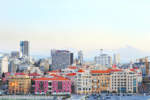Former City Centre Complex built by Philip Joseph Karam in 1965
Nicola Santini: You are the author of several essays and studies on urban transformations in Beirut and on city center recovery. What is your opinion about Solidere reconstruction?
Robert Saliba: I‘d like to go beyond the controversy that has surrounded Solidere since its inception. Standard criticism for the past ten years mostly revolved around the absence of social mixity within the city center, Solidere being for the rich and Gulf tourists, excluding a major section of Beirut’s population. Looking at the steady and fast increase in real estate prices, it's not the city center that is only for the rich, all Beirut is gentrifying. In this respect, Beirut is not different from New York or Paris. We do not have, and have never had, a strategy for social housing. Beirut, within and outside Solidere, is ruled by the market forces. It's extremely difficult to find affordable small apartments in the city. The new generation is moving out to the near and far suburbs and Beirut is expanding with no metropolitan plan.
Another standard criticism is the loss of historic identity; Beirut is neither Damascus nor Cairo. Its medieval core was already razed and modernized by the Ottomans and the French during the first quarter of the 20th Century. Beirut is not a dual city with a historic core and a modern center co-existing next to each other. The modern was superimposed on the old one hundred years ago.
What’s left above ground is colonial and modern. The rest is archaeological, underground. Beirut is a layered city fascinated by modernity; it is a recent colonial creation of the French intended to be a gateway to the region. That is its identity. If we want to get romantic and see pre-colonial Beirut, we can visit next door in old Tripoli, Sidon, or Damascus.
C.M.-N.S.: Do you think that in the city centre and in the rest of Beirut is happening almost the same thing but at a different scale, miniaturized?
R.S.: There are two planning systems in Beirut; a corporate planning system within Solidere, and an aging bureaucratic system encompassing the rest of the city. One is flexible and coordinated; the other is static and plagued with bureaucratic inefficiency. Both are market-driven. The first is framed by a recent master plan constantly adjusting to market demands; the other is subject to blanket zoning dating back to the 1950s. The golden period, of civic design and town planning, dates back to the colonial rule by the Ottomans and the French. Since independence, urbanism has only been concerned with accommodating traffic and optimizing real estate development within and outside the city center; it still is.
The preservation of part of the urban fabric in Solidere was only possible due to the transfer of air right from the existing city center to the reclaimed land from the sea. This is difficult outside Solidere. All colonial period structures will therefore be replaced by high rise buildings, very soon.
N.S.: What do you think about the fact that the social life is still not happening in the city centre but it's happening in other part of the city like Hamra and Gemmayzeh?
R.S.: Well, you have to keep in mind that other parts of the city were not drastically destroyed and reconstructed from scratch like the city center.
They still had their old inhabitants. I think that “social life” (I don't know exactly what you mean by “social life”) is happening both within Solidere and outside, but differently. In the city center, it revolves around and within gated communities like Saifi, the conservation district, and in the new souks. All high end. Each city needs its dreamland, its Fifth Avenue, and Champs- Élysées. Zaitouni bay is becoming a prime attraction for all Beirutis (both pro- and anti-solidere) who are delighted to have a high quality public space, which has not existed since the haussmanization of Beirut in1920s and 1930s. On the periphery, Gemayzeh is catering, during the night, to trendy youngsters and yuppies; during the day, the district is “very calm” with little “social life”, compared to the pre-war period. It is increasingly being gentrified like Saifi next door… like all Beirut. The most interesting phenomenon remains “Hamra reborn” and the whole district around the American University of Beirut which has always acted as a catalyst for mixity and cosmopolitanism. The “campus island” is the only “melting pot” left in the city (however a melting pot for Moslem and Christian upper and middle bourgeoisie only). Beirut is not really happening, either in the center like Soldere or in sub-centers like Hamra; Beirut is really happening in the suburbs. This is what your article should have dealt with; centralit(y) replaced by centralit(ies).
Robert Saliba is Associate Professor of Architecture, Urban Design and Planning at the American University of Beirut. He holds a Master Degree in Urban Planning from The University of Michigan-Ann Arbor (1980), and a PhD in Urban and Architecture History from the University of Paris VIII (2004). He is the author of Beyrouth Architectures: aux sources de la modernité 1920-1940 (Parenthèses, 2009); and Beirut City Center Recovery: The Foch-Allenby and Etoile Conservation Area (Steidl, 2004). Saliba is the recipient of the British Chevening Scholarship for Post Graduate Research (96-97), and was a visiting professor in urban design and postwar reconstruction at the the Department of Architecture, Technical University of Damstadt, Germany (spring term 2011). He acted as a land use planning consultant for international organizations such as the World Bank and UN-Habitat. He also worked as City Planning Associate at Community Redevelopment Agency of the City of Los Angeles (1980-83).






